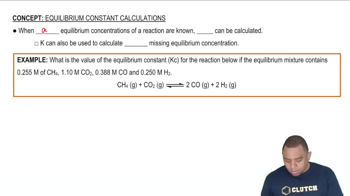Here are the essential concepts you must grasp in order to answer the question correctly.
Weak Acids and Their Dissociation
Weak acids are substances that partially dissociate in solution, establishing an equilibrium between the undissociated acid and its ions. The strength of a weak acid is quantified by its acid dissociation constant (Ka), which indicates the extent of dissociation. For saccharin, with a Ka of 2.1 x 10^-12, this means that only a small fraction of the acid molecules donate protons (H+) to the solution, making the calculation of hydronium ion concentration (H3O+) crucial.
Recommended video:
Equilibrium and the ICE Table
In chemical equilibria, the concentrations of reactants and products remain constant over time. The ICE (Initial, Change, Equilibrium) table is a useful tool for organizing the concentrations of species involved in a reaction at different stages. For the dissociation of saccharin and water, setting up an ICE table allows for the systematic calculation of H3O+ concentrations by accounting for the contributions from both the weak acid and the autoionization of water.
Recommended video:
ICE Charts and Equilibrium Amount
Simultaneous Equations in Equilibrium Calculations
When dealing with multiple equilibria, such as the dissociation of a weak acid and the autoionization of water, simultaneous equations are often necessary to find the concentrations of all species involved. In this case, the concentration of H3O+ from both the dissociation of saccharin and the water must be considered together. Solving these equations allows for a comprehensive understanding of the system's behavior and the accurate calculation of the hydronium ion concentration in the saturated solution.
Recommended video:
Equilibrium Constant Calculation




